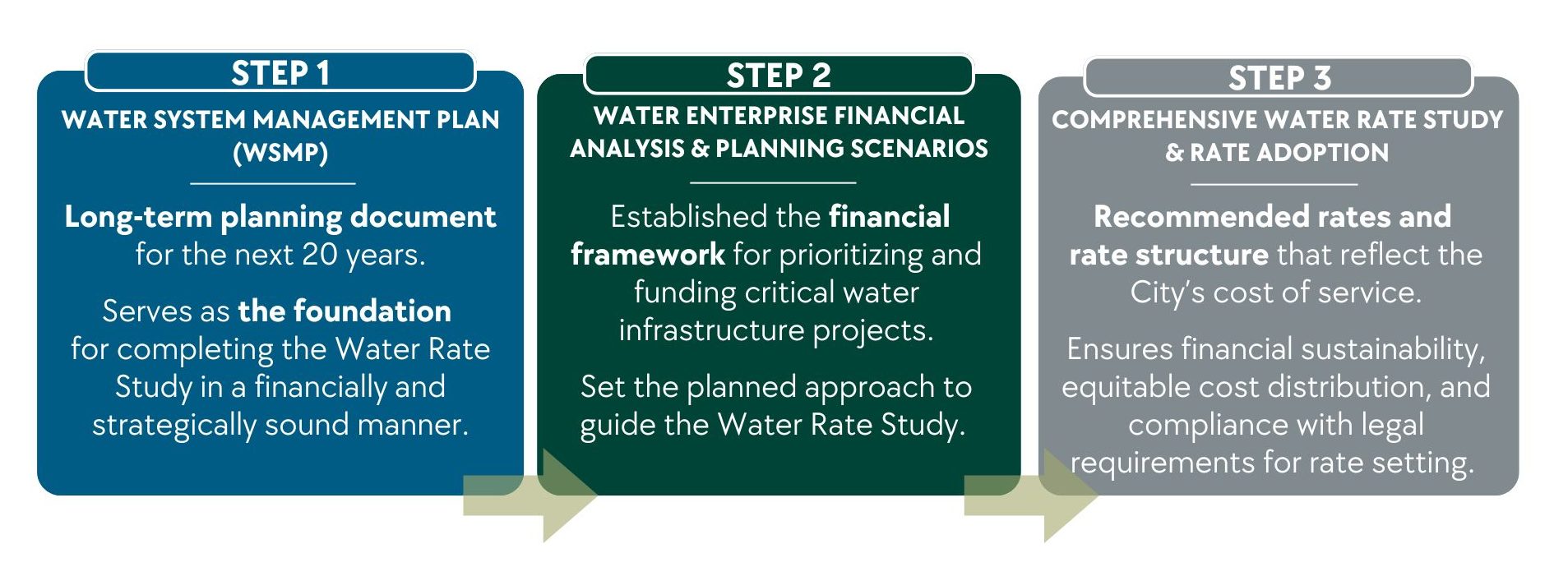- Pleasanton Water
- About Our Water
- Water Quality & Safety
- Investing in the Future
- Sewer Service & Programs
- Customer Service & Utility Billing
- Water Conservation Programs
- Water Rates
- Sewer Rates
- Recycled Water Program
- Near-Term Water Improvement Projects
- Joint Groundwater Wells Project
- Cross-Connection Control & Backflow Prevention Program
- Clean Water Program
Water Rates
About Pleasanton’s Water Rates
The City of Pleasanton is committed to maintaining an equitable and justifiable rate structure that supports reliable water service and long-term financial sustainability. Pleasanton’s water system is funded by a separate Water Enterprise Fund, which covers all water-related services and infrastructure.
The City purchases 100% of its water from the Zone 7 Water Agency, which charges the City both fixed and variable costs. The city’s utility bills also include applicable city rates for water (both fixed and variable), sewer, irrigation, and recycled water. Sewer rates include local collection charges from the City of Pleasanton, as well as pass-through charges for wastewater treatment from the Dublin-San Ramon District (DSRSD) or City of Livermore.
History of Pleasanton Water Rates
Delivering safe, reliable water requires extensive infrastructure and ongoing maintenance. Over time, the cost of providing water service has increased. To keep pace, the City and Zone 7 Water Agency regularly review their rates in response to rising costs, new regulations, and evolving system requirements.
From 2011 to 2023, while Zone 7 raised its fixed and variable water rates, the City’s water rates were adjusted only for inflation. During this period, the City also provided the first 20 CCF (hundred cubic feet) of water free of charge to all customers.
In 2022, the City discontinued use of its groundwater wells due to concerns about PFAS and began relying entirely on imported water from Zone 7. This shift significantly increased the cost of water. In 2023, the City approved a two-year emergency rate increase to stabilize funding and support critical infrastructure needs. The new rates, a 30% increase and a 12% increase, took effect in 2024 and 2025, respectively.
Water Rate Update – 2025
Like most water providers across California, Pleasanton is facing challenges related to aging infrastructure, stricter regulatory requirements, higher water quality standards, and rising construction costs. Since 2023, the City has taken a strategic, progressive approach to planning for the future of its water system.
The City Council held a public hearing on Tuesday, October 7, 2025. Following the hearing, the City Council unanimously adopted the new water rates for the next four years, beginning January 1, 2026. View the proposed rates for the next four years.
Did you know?
Emergency repairs can cost up to 10 times more than proactive infrastructure maintenance and upgrades.
2025 Water Rate Process: Completed Rate Adoption
In September 2024, the City of Pleasanton launched a comprehensive, three-step process to update its water rates and ensure the long-term financial health of its water enterprise fund.
This strategic effort — grounded in cost-of-service principles and compliance with Proposition 218 — focused on supporting critical infrastructure investments, maintaining system reliability, and promoting equity and transparency.
The City Council unanimously adopted the new rates on October 7, 2025, with the first adjustments taking effect January 1, 2026.
Step 1: Water System Management Plan (WSMP)
Status: Adopted January 2025
In January 2025, Pleasanton completed its first long-term water planning document, the Water System Management Plan (WSMP). This document serves as the foundation for completing the 2025 Water Rate Study in a financially and strategically sound manner. The WSMP:
- Outlines all water system assets
- Identifies capital improvement and maintenance needs over the next 20 years
- Guides near-, mid-, and long-term system improvements
- Serves as the foundation for all future rate-setting and financial planning
Step 2: Water Enterprise Financial Analysis & Funding Scenarios
Status: Completed March 2025
In March 2025, the City conducted a financial analysis and identified funding scenarios to establish the financial framework for prioritizing and funding critical water infrastructure projects over the next five years. The analysis included:
- Operational costs, infrastructure needs, and revenue options
- Long-term impacts on financial stability and ratepayers
- Informed a prioritized investment strategy to complete $73 million in Critical Infrastructure Projects in the next five years
The City Council approved the enhanced project delivery model, which takes a balanced approach by accelerating the most critical infrastructure upgrades while minimizing long-term risk to the City. Learn More
Step 3: Water Rate Study & Rate Adoption (Completed October 2025)
The City has completed the final step in its water rate-setting process, which involved a comprehensive review of Pleasanton’s water system needs and financial outlook to ensure rates accurately reflect the cost of providing service.
This process included:
A cost-of-service analysis and rate study to ensure equity, transparency, and legal compliance with Proposition 218.
Updated connection fees to reflect current and future infrastructure demands.
Evaluation and adjustment of water and drought rates to align with long-term operational needs.
A formal Proposition 218 notification and hearing process that included public outreach, comment, and Council consideration.
The City Council held a public hearing on Tuesday, October 7, 2025. Following the hearing, the City Council unanimously adopted the new water rates for the next four years, beginning January 1, 2026.
2025 Adopted Water Rates & Background
This section provides a summary of the adopted rates, background documents, and the supporting analysis used during the 2025 rate-setting process.
On October 7, 2025, the City Council unanimously adopted new water rates. The first adjustments take effect January 1, 2026. View the City Council Staff Report.
1. Adopted Water Rates
Below are links to the rate adjustments for the City of Pleasanton water rates over the next four years. Once adopted, customers will be informed annually of rate changes at least 30 days before the effective date.
The rates reflect the City’s overall capital improvement and financial needs, as well as changes to its rate structure. These changes include implementing uniform, consumption-based variable charges for all customers and recovering 100% of Zone 7’s fixed costs as pass-through fixed charges to customers.
Please note that most single-family residential customers have a 5/8″ or 3/4″ meter, which will determine the applicable fixed service charge under the proposed rate structure. The impact of these rate changes will vary based on your meter size and water use.
In addition, the City purchases 100% of its potable water from the Zone 7 Water Agency, which charges the City both fixed and variable costs. Pursuant to Government Code §53756 (AB 3030 [2008]), these charges are pass-through costs collected by the City of Pleasanton to cover the purchase and delivery of wholesale water. Therefore, the Zone 7 rates are proposed based on the assumption of a 5% annual increase. However, these rates are subject to change based on the actual rates set by Zone 7.
The impact of these rate changes on your bi-monthly bill will vary from customer to customer. Below are links to images showing the estimated impact for Single Family Customers with 5/8″ Meters in the first year and over the next four years:
2. Water Drought Rates
Water shortages occur when the availability of the water supply fails to meet expected customer demand. Such a shortage can arise for various reasons, including an earthquake, a power outage, or an extended drought. In these situations, water usage declines, leading to reduced revenues for the City from variable charges.
Water drought rates, or consumption-based surcharges, serve as tools to effectively respond to water shortage emergencies and recover essential funding necessary to operate and maintain the water system. As outlined in the City’s Water Shortage Contingency Plan, drought rates are implemented in stages for different levels of mandated water usage reduction.
Water drought rates can only be enacted if the City Council declares a water shortage emergency and implements drought rates corresponding to the appropriate stage. They are designed to recover variable revenue loss from reduced usage minus the expected cost savings from decreased variable expenses, such as purchasing less water from Zone 7. These water drought rates represent one of several options available to agencies during a water shortage emergency and are implemented at the discretion of the City.
The City’s current water drought rate structure provides a usage allotment of 10 CCF for all customers every bi-monthly billing period, which is exempt from charges. Based on updated consumption patterns, staff recommends reducing the drought allotment to 8 CCF per bi-monthly period to ensure the total annual usage allotment remains below the annual usage reduction requirement for each water shortage stage.
The Water Drought Rates and Connection Fees Technical Memo and presentation shared with the City Council compare these two allotments, the respective water drought rates for each option, and the proposed bill impacts for single-family customers.
It is important to note that since the City has decided to proceed with 100 percent fixed charge recovery of Zone 7 fixed costs, the proposed water drought rates are lower than the current drought rates, as less variable revenue will now be at risk during water shortage emergencies.
3. Water Connection Fees
Water connection fees are one-time capital charges assessed to new developments connecting to the City’s water system. These fees ensure that new customers pay their fair share of the cost to expand and maintain the water system capacity needed to serve future growth.
Connection fees may be based on several industry-standard calculation methods:
- Incremental Cost Method: New users pay for the additional capacity and infrastructure required to expand the existing system.
- Buy-In Method: New users pay for a share of the existing system’s value, reflecting capacity already built and available for growth.
- Hybrid Method: Combines both the incremental and buy-in methods when there is some available capacity but also new investments needed to serve future development.
Pleasanton’s City of Pleasanton water system has some existing capacity due to conservation trends. However, as identified in the Water System Management Plan (WSMP), targeted system expansion is needed to support future growth, particularly for water supply transmission and storage.
To balance equity, financial sustainability, and growth impacts, the City Council adopted the Hybrid Method for calculating water connection fees.
- Adopted Water Connection Fee: $5,269 per Dwelling Unit Equivalent (DUE)
- Effective Date: January 1, 2026
- Annual Adjustment: Fees will be adjusted annually based on the Consumer Price Index (CPI) to reflect inflation and maintain cost recovery over time.
As the City updates its water system planning in future years, the connection fee may be revised to reflect updated capital project costs and system valuations.
4. 2025 Water Rate Study
The 2025 Water Rate Study provided the foundation for the City’s adopted water rate structure and rates, aligning with the Water System Management Plan (WSMP) and the long-term funding priorities outlined in the City’s Financial Analysis and Plan.
The study included a comprehensive cost-of-service analysis to ensure that water and recycled water rates are equitable, transparent, and legally compliant under Proposition 218.
Key adopted changes:
- Full cost recovery of Zone 7 Water Agency fixed costs through fixed service charges, improving revenue stability and reducing legal risk.
- Uniform consumption-based variable rate for all customer classes, replacing the previous tiered structure for single-family customers.
- Updated drought rates and connection fees to support system reliability and growth.
Based on the adopted rates, approximately 52% of bi-monthly single-family water bills are expected to increase by $20 to $40 in the first year (effective January 1, 2026).
The full rate schedules — including water and connection fee rates for the next four years — are available in the Proposition 218 Public Hearing Notice and the Council staff report.
5. Utility Discount Program
The City of Pleasanton is updating its Utility Discount Program to better support residents who need financial assistance with their water and sewer bills. The new program will take effect March 2026, with the application and registration period opening February 1, 2026.
Under the updated program, eligible residential customers will receive a 30% discount on their water and sewer bills.
To make the program simpler and more accessible, eligibility will now be based on enrollment in the PG&E CARE Program, creating a more consistent and streamlined application process.
Residents may qualify if:
- They receive water service directly from the City of Pleasanton, and
- They are enrolled in the PG&E CARE Program.
If you are currently enrolled in the PG&E CARE Program, you will be eligible to apply for the City’s new discount program once the registration period opens.
The City will continue to share updates through newsletters, and utility bills. Please watch for more details in the coming months.
Learn more about the PG&E California Alternate Rates for Energy (CARE) Program
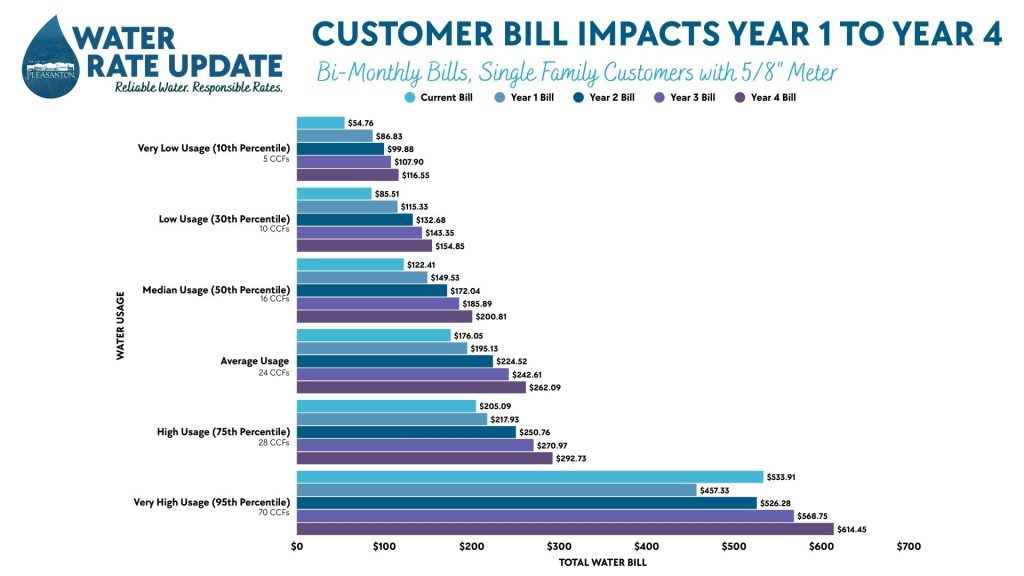
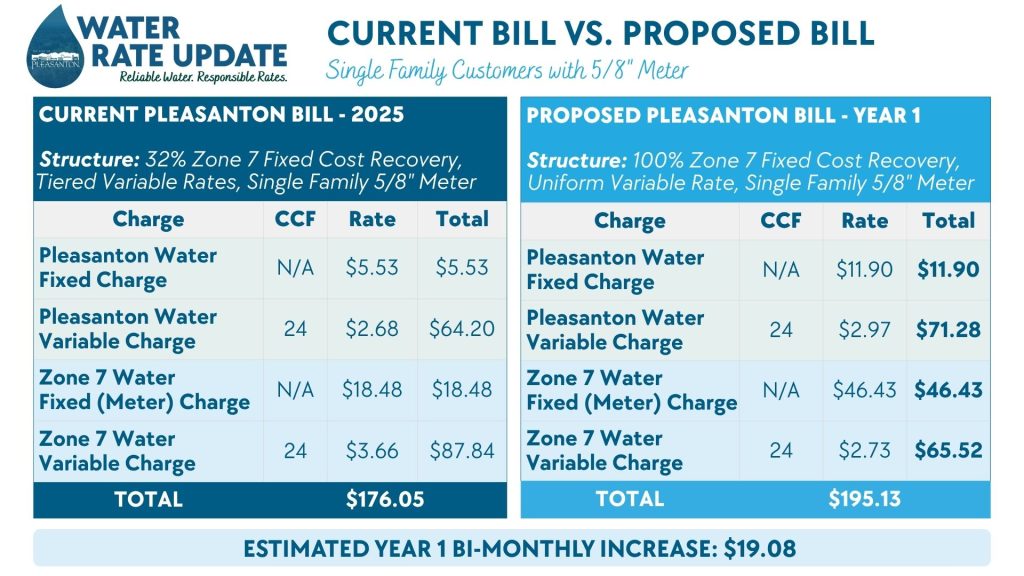
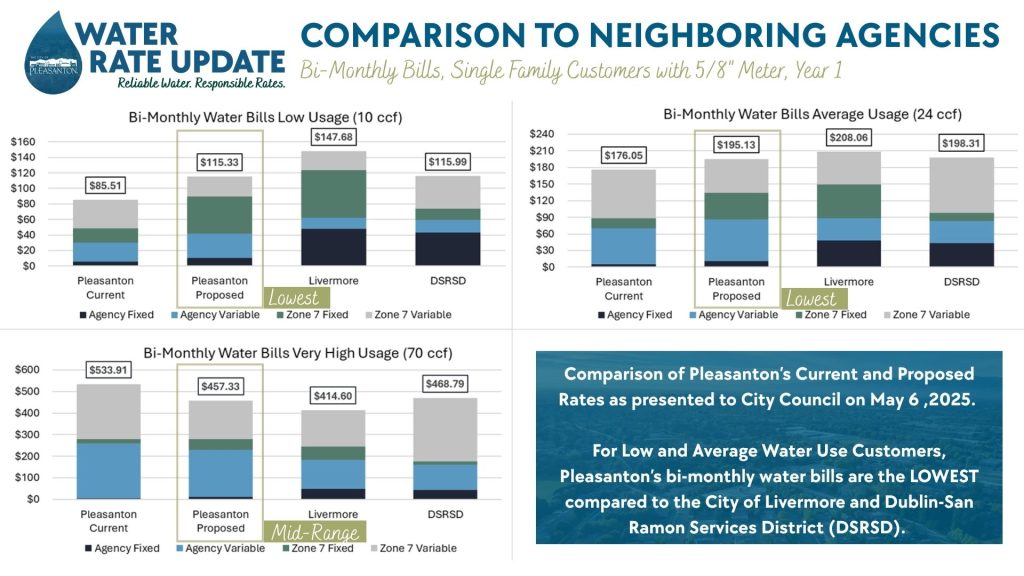
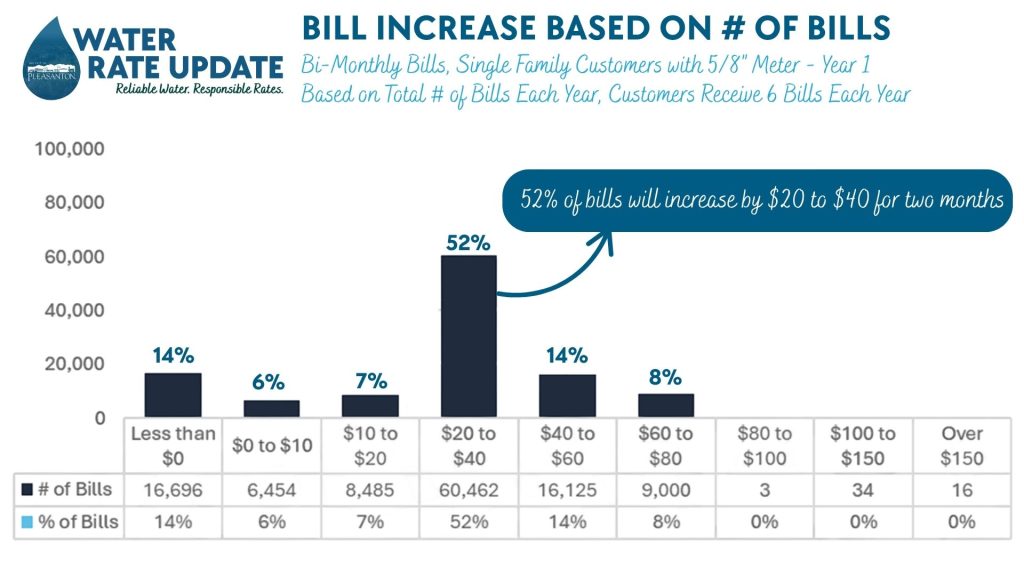
Frequently Asked Questions
Why is the City adjusting its water rates?
The City must regularly assess its water rates and fees to ensure they address the industry’s growing challenges and sufficiently cover the City’s cost of service. The City relies on revenues from water rates to fund the operations and maintenance of the local water system. Like most water providers across California, Pleasanton faces challenges related to aging infrastructure, stricter regulatory requirements, higher water quality standards, and rising construction costs.
Top factors driving the City’s proposed rate increases include:
- Investing $73 million over the next five years to maintain, repair, and replace the City’s aging water infrastructure to improve its long-term reliability and functionality.
- Adjusting the City’s rate structure for single-family customers from a tiered to a uniform rate structure.
- Achieving full cost recovery on Zone 7 fixed costs to the City.
- Keeping up with rising costs in various services, including construction, water supply, energy, and professional staffing.
- Securing a sustainable, safe local water supply.
- Investing in technology to mitigate risk and enhance the City’s water system.
- Meeting increasing regulatory mandates and requirements.
How did the City determine the proposed adjustments to its water rates?
Since 2023, the City has adopted a strategic and systematic approach to investing in the future of its water system. In September 2024, the City officially began its rate-setting process by contracting with Water Resources Economics, LLC, to conduct a comprehensive water rate study and develop cost-based, equitable, and legally defensible rates in compliance with Proposition 218 and industry best practices.
In January 2025, the City adopted its first Water System Management Plan (WSMP), outlining its water system assets, recommended capital improvement needs, and operational and maintenance requirements for the next 20 years. Building on this plan, the City conducted a financial analysis to explore how to proceed with these future investments. The City approved an enhanced delivery method that balances the urgency of critical infrastructure upgrades while minimizing long-term risks to the City. These steps set the foundation and financial framework for conducting a comprehensive water rate study. This study included a cost-of-service analysis and recommended changes to the rate structure and rates that align with the WSMP’s needs and the funding priorities outlined in the Financial Analysis to ensure that rates adequately reflect the City’s cost of service.
When would the new rates take effect?
The new rates will take effect on January 1st of each year for the next four years, starting on January 1, 2026.
What are fixed vs. variable water charges?
Fixed charges are established fees for customers, regardless of water usage. These charges remain constant and are determined by the customer’s water meter size. Customers in Pleasanton have two fixed charges on their bills: one from the City for water delivery and another from Zone 7 for supplying the water. City fixed costs include staffing, maintenance, meter reading, and infrastructure repair and replacement. Zone 7’s fixed costs to the City are set by Zone 7.
Variable or consumption-based charges change from bill to bill based on the amount of water used, measured in hundred cubic feet (CCFs). Pleasanton has two variable charges: Zone 7 variable charges related to water supply purchases from Zone 7 and City variable charges related to the City’s water delivery to customers. Typical variable costs include the volume of water purchased, energy expenses to pump and move water through the system, water treatment, operations and maintenance, regulatory compliance such as testing and monitoring, and conservation programs.
What changes has the City made to its water rate structure?
On October 7, 2025, the City Council adopted two key changes to Pleasanton’s water rate structure to ensure the system remains financially sustainable, transparent, and compliant with Proposition 218:
Uniform Consumption-Based Rates for All Customers
The City has transitioned from a tiered rate structure for single-family customers to a uniform rate structure for all customer classes.
Tiered rates were originally designed to promote water conservation and affordability for lower water users. However, recent court decisions in California have clarified that tiered structures must directly reflect the actual cost of providing service.
To reduce legal exposure and ensure compliance with Proposition 218 — which requires rates to be proportional, cost-based, and not exceed the cost of service — the City adopted a uniform volumetric charge.
This simplifies billing, ensures fairness across customer types, and reduces administrative complexity.
Full Cost Recovery of Zone 7 Fixed Charges
Previously, only a portion of Zone 7 Water Agency’s fixed wholesale costs was recovered through the City’s fixed service charge, with the remainder built into the variable volumetric rate.
This structure made City revenues vulnerable to fluctuations in customer water use, drought conditions, and weather patterns.
The new structure fully recovers Zone 7’s fixed costs through the fixed service charge as a pass-through of Zone 7’s rates.
This improves financial stability, supports long-term infrastructure investment, and reduces reliance on unpredictable consumption levels.
These changes take effect January 1, 2026 and are designed to provide a more stable, legally defensible, and transparent water rate structure for Pleasanton customers.
How will these rate changes affect my bill?
The impact of these rate adjustments will vary based on customer type and water usage. In Year 1, the expected effects on bi-monthly water bills for single-family customers are as follows:
- $0 to $10 bi-monthly increase: 6% of single-family bills
- $10 to $20 bi-monthly increase: 7% of single-family bills
- $20 to $40 bi-monthly increase: 52% of single-family bills
- $40 to $60 bi-monthly increase: 14% of single-family bills
- $60 to $80 bi-monthly increase: 7% of single-family bills
- Bi-monthly decrease: 14% of single-family bills
Based on this breakdown, most single-family customers will experience an increase of $20 to $40 every other month since the City bills bi-monthly.
Can the City use funds from water rates for other uses?
No, Pleasanton’s water system is funded by a separate Water Enterprise Fund that covers all water-related services and infrastructure. The City cannot profit from the rates charged to customers or use these funds for other purposes. Customer rates directly support the costs associated with providing water and recycled water services, including daily operations, maintenance, and repairing and replacing essential infrastructure.
When was the last time the City increased its water rates?
Delivering safe, reliable water requires extensive infrastructure and ongoing maintenance. Over the years, the cost of providing water service has increased. To keep up, the City and Zone 7 Water Agency regularly review their rates in response to rising costs, new regulations, and evolving system requirements.
From 2011 to 2023, while Zone 7 raised its fixed and variable water rates, the City’s water rates were adjusted only for inflation. During this period, the City also provided all customers the first 20 CCF (hundred cubic feet) of water free of charge.
In November 2022, the City discontinued the use of its groundwater wells due to increasing per- and polyfluoroalkyl (PFAS) regulatory requirements and began relying entirely on imported water from Zone 7. This shift significantly increased the cost of water. In 2023, the City approved a two-year emergency rate increase to stabilize funding and support critical infrastructure needs. The new rates, a 30% increase and a 12% increase, took effect in 2024 and 2025, respectively.
What is the Zone 7 Water Agency and how is it different from the City?
The City owns and operates water and recycled water systems that deliver potable and recycled water to its customers and a sewer system that conveys sewage to wastewater treatment plants.
Zone 7 is a wholesale water agency responsible for securing, treating, and supplying water to retailers like the City of Pleasanton, which then distributes water directly to residents and businesses.
Pleasanton maintains and operates its local water distribution system, while Zone 7 manages regional treatment facilities, major transmission lines, and regional groundwater basin management.
How were Zone 7's proposed rates determined?
Zone 7 charges are pass-through costs collected by Pleasanton to cover the purchase and delivery of wholesale water. Zone 7 establishes its fixed and variable rates. The City’s proposed rates include Zone 7’s rates based on the assumption of a 5% increase each year. However, this assumption can change annually based on the rates set by Zone 7.
What are recycled water rates, and to whom do they apply?
The City purchases and delivers recycled water to customers in limited parts of its service area. The costs and revenue requirements for the recycled water program are calculated separately from those of the potable water system and paid for by recycled water customers. The proposed rate structure for recycled water includes a fixed charge and a variable charge for both the supply and distribution of recycled water.
What are drought rates?
A water shortage occurs when there is insufficient water to serve customers. Such a shortage can arise for various reasons, including an earthquake, a power outage, or an extended drought. In these situations, water usage declines, resulting in reduced revenues. Drought rates, or consumption-based surcharges, serve as a tool to effectively respond to water shortage emergencies and recover essential funding necessary for operating and maintaining the water system. Drought rates are implemented in stages for different levels of mandated water usage reduction, as outlined in the City’s Water Shortage Contingency Plan.
Drought rates can only be enacted if the City declares a water shortage emergency and chooses to implement drought rates that correspond to the appropriate stage. These rates are discretionary and are one of several options available to agencies during a water shortage emergency. Other strategies to recover drought-related costs include using reserve funds, implementing a partial drought rate, deferring CIP expenditures, and more.
As part of the October 7, 2025 adoption of new water rates, the City also updated its drought rates. Because the new water rate structure fully recovers Zone 7 Water Agency fixed costs through fixed charges, less revenue is at risk during water shortage events. As a result, the new drought rates are lower than previous drought rates, helping keep customer bills more stable during emergencies.
These updated drought rates take effect January 1, 2026, but would only be applied if a water shortage emergency is declared.
What are connection fees?
Connection fees are one-time capital fees assessed against new developments in the City to recover the proportional share of capital facility investment to be constructed or previously constructed to accommodate new growth.
Why is the City prioritizing so many infrastructure projects at this time?
The City’s water system is aging and requires significant repairs and upgrades. Consequently, in recent years, the City has experienced an increase in emergency repairs. These emergency repairs can cost over ten times the amount of capital replacement and upgrades. To ensure a safe and reliable water supply, the City plans to invest $73.5 million in capital improvement projects over the next five years to upgrade and rehabilitate its existing water system.
What essential infrastructure projects is the City expecting to repair or replace in the next five years?
In January 2025, Pleasanton completed its first long-term Water System Management Plan, which assessed existing water assets, anticipated capital improvements, and outlined operations and maintenance requirements for the next 20 years. Subsequently, the City conducted a Water Enterprise Financial Analysis outlining multiple funding scenarios to create a financial framework for prioritizing and funding critical water infrastructure projects to address the City’s immediate and future water needs.
Based on this analysis, the City identified over $73 million in capital upgrades and repairs for the next five years to maintain and enhance its aging infrastructure systems. Key projects planned include:
- Emergency Power Improvements
- Water Meter and AMI System Replacement
- West Las Positas Blvd. Multimodal Reconstruction
- Annual Water Program
- Regional Well and Pipeline Project
- Kilkare and Sunol Fire Flow
- Annual Pipeline Upgrades for Fire Flow
- Grey Eagle Improvements
- Water Tank 1300 Rehabilitation
- SCADA Network Architecture
- Water Tank Inspections and Repair
- Foothill Pump Station Rehabilitation
- Annual Pipeline Capacity Improvements
This list of projects is proposed and may change over time. The projects identified are based on the city’s highest priorities, which are to ensure the delivery of safe and reliable water to our customers.
Do these proposed rate changes have any impact on sewer rates?
No. The City owns and operates water and recycled water systems that provide potable and recycled water to its customers and a sewer system that transports sewage from these customers to wastewater treatment plants. Each of these services is financially managed by a separate enterprise fund. Water and wastewater, or sewer, rates are evaluated and established separately based on the costs of providing each service. The City plans to conduct a comprehensive wastewater rate study next year.
Does the City offer programs to help conserve water and lower my bill?
Yes, the City offers various water conservation services, free devices, and rebate programs to help customers save water and money. Find out more on our Water Conservation webpage.
Stay Informed
- Sign Up for the Pleasanton Pipeline e-Newsletter
- Follow Us on Social Media – Facebook, Instagram for the latest Pleasanton Water News
- Submit a Comment or Question via Email
- Questions? Contact Public Works at (925) 931-5500
or the Resident Feedback Form
Additional Rate Information
Water Rate Update 2025
- Agenda Report & City Council Presentation – July 15, 2025
- Prop 218 Notice – July 15, 2025
- Water Rate Study Report – July 15, 2025
- Agenda Report & City Council Presentation – June 3, 2025
- Water Drought Rates and Connection Fees Technical Memo – June 3, 2025
- Agenda Report & City Council Presentation – May 6, 2025
- Water Rate Design Analysis Technical Memo – May 6, 2025
- Agenda Report – October 7, 2025
- Current rate information (as of January 1, 2025) can be found here.
Current Water Rate Information
Water Rate Update 2023
Links to 2023 Rate Change Materials currently available on water rate page
- Pleasanton Water Rates Frequently Asked Questions (updated 10/5/23)
- Detailed information on the rate increases can be found in the City’s agenda report from the November 7, 2023 City Council meeting (item #17).
- Public Hearing Notice – A Public Hearing Notice was sent to all Pleasanton addresses in early August 2023.
- A press release with additional information.
- Final Water and Recycled Water Rate Study report.
- Current rate information (as of January 1, 2025) can be found here.
Water and Sewer Rate Archive
- 2024 Rate Notification Inserts SEWER DSRSD 07-01-24
- 2024 Rate Notification Inserts SEWER Livermore 07-01-24
- 2024 Rate Notification Inserts Water
- 2024 Rate Notification Inserts SEWER DSRSD 01-01-24
- 2024 Rate Notification Inserts SEWER Livermore 01-01-24
- 2023 Rate Notification Inserts Water
- 2023 DSRSD Sewer Rate Sheet
- 2023 City of Livermore Sewer Rate Sheet
- 2022 Water Rates Notification
- 2022 City of Livermore Sewer Rate Sheet
- 2022 DSRSD Sewer Rate Sheet
- 2021 City of Livermore Sewer Rate Notification
- 2021 DSRSD Wastewater Rate
- 2020 City of Livermore Sewer Rate
- 2020 DSRSD Wastewater Rate Notification
- 2020 Water Rates

